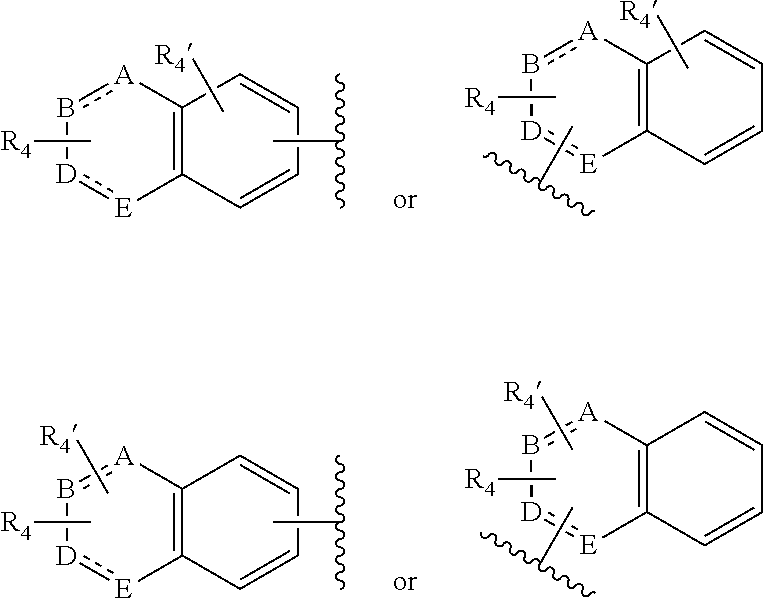Nitrogen containing bicyclic derivatives for treating pain and pain related conditions
a technology of bicyclic derivatives and nitrogen, which is applied in the direction of nervous disorders, organic chemistry, drug compositions, etc., can solve the problems of unrelief for patients, significant productivity loss and socio-economical burden, and much less than optimal in the safety ratio
- Summary
- Abstract
- Description
- Claims
- Application Information
AI Technical Summary
Benefits of technology
Problems solved by technology
Method used
Image
Examples
example 1
N-Methyl-3-((1-methyl-1,2,3,4-tetrahydroquinolin-5-yl)oxy)-3-(thiophen-2-yl)propan-1-amine
[0314]
[0315]Step 1. 5-(3-Chloro-1-(thiophen-2-yl)propoxy)-1-methyl-1,2,3,4-tetrahydro quinoline: To a solution of 3-chloro-1-(thiophen-2-yl)propan-1-ol (0.39 g, 2.21 mmol), tributylphosphine (0.66 mL, 2.65 mmol) and 1-methyl-1,2,3,4-tetrahydroquinolin-5-ol (0.36 g, 2.21 mmol) in toluene (15 mL), ADDP (0.67 g, 2.65 mmol) was added. The mixture was stirred at 100° C. overnight. The suspension was filtered through a pad of Celite that was washed with toluene and the filtrate was concentrated under vacuum. The crude product was used in the next step without further purification (1.38 g, overweight, quantitative yield assumed).
[0316]Step 2. Title compound: In a sealed tube, a mixture of the product obtained in Step 1 and methylamine (33 wt % in EtOH, 5.3 mL, 42.4 mmol) was heated at 100° C. overnight. Then, it was concentrated to dryness. The residue was dissolved in DCM (10 mL) and it was washed wi...
example 4
(R)—N-Methyl-3-(phthalazin-5-yloxy)-3-(thiophen-2-yl)propan-1-amine
[0319]
[0320]To a solution of Intermediate 4 (75 mg, 0.44 mmol) in anhydrous DMA (3 mL) cooled at 0° C., NaH (60% dispersion in mineral oil, 44 mg, 1.10 mmol) was added portionwise under a nitrogen atmosphere. After stirring for 30 min at 0° C., a solution of 5-fluorophthalazine (65 mg, 0.44 mmol) in anhydrous DMA (2 mL) was added and the reaction mixture was heated at 50° C. for 1.5 h. It was then cooled to 0-5° C. and then water was added. The aqueous phase was extracted with DCM and the combined organic phases were dried over MgSO4 and evaporated to dryness. The crude product was purified by flash chromatography, silica gel, gradient DCM to MeOH:DCM (1:4) to give the title compound (34 mg, 49% yield).
[0321]HPLC retention time (method A): 2.44 min; MS: 300.1 (M+H).
[0322]This method was used for the preparation of Examples 5-16 using suitable starting materials:
RettimeMSHPLCEXStructureChemical name(min)(M + H)Method5...
example 17
3-(Isoquinolin-5-ylmethoxy)-N-methyl-3-phenylpropan-1-amine
[0323]
[0324]Step 1. tert-Butyl (3-(isoquinolin-5-ylmethoxy)-3-phenylpropyl)(methyl) carbamate: To a suspension of NaH (70 mg, 60% dispersion in mineral oil, 1.74 mmol) in THF (2 mL) cooled at 0° C., a solution of tert-butyl (3-hydroxy-3-phenylpropyl)(methyl)carbamate (181 mg, 0.7 mmol) in THF (9 mL) was added. The reaction mixture was stirred at r.t. for 60 min and then a solution of 5-(chloromethyl)isoquinoline (145 mg, 0.82 mmol) in THF (5 mL) and tetrabutylammonium iodide (22 mg, 0.6 mmol) were added at 0° C. The reaction mixture was heated at 45° C. for 24 h. NH4Cl sat. solution was added and it was extracted with DCM. The organic phase was dried over Na2SO4, filtered and concentrated under vacuum. The residue was purified by flash chromatography, silica gel, gradient Hexane to Hexane:EtOAc 1.5:1, to afford the title compound (147 mg, 53% yield).
[0325]Step 2. Title compound: To a solution of the product obtained in Step ...
PUM
| Property | Measurement | Unit |
|---|---|---|
| Time | aaaaa | aaaaa |
| Time | aaaaa | aaaaa |
| Time | aaaaa | aaaaa |
Abstract
Description
Claims
Application Information
 Login to View More
Login to View More - R&D
- Intellectual Property
- Life Sciences
- Materials
- Tech Scout
- Unparalleled Data Quality
- Higher Quality Content
- 60% Fewer Hallucinations
Browse by: Latest US Patents, China's latest patents, Technical Efficacy Thesaurus, Application Domain, Technology Topic, Popular Technical Reports.
© 2025 PatSnap. All rights reserved.Legal|Privacy policy|Modern Slavery Act Transparency Statement|Sitemap|About US| Contact US: help@patsnap.com



